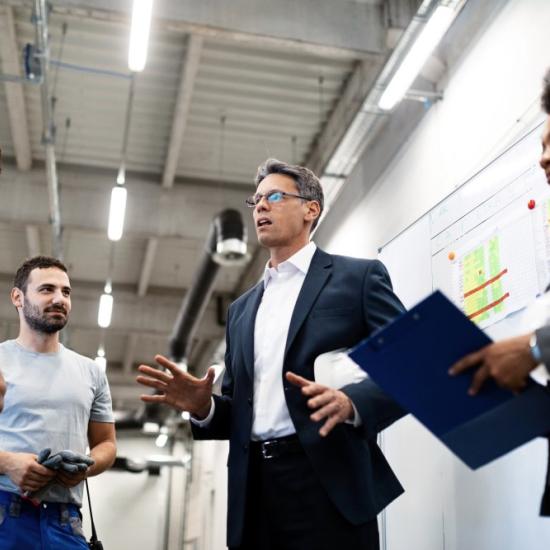In order to more easily absorb large fluctuations in production while simultaneously improving the working relationship between the production and sales departments, West Flanders-based IRBF decided that a thorough approach was needed. QRM, lean and Toyota Kata were introduced in production and administration.
Located in Ypres, IRBF is a subsidiary of Bandencentrale Forrez, specialising in the production of wheel rims for machinery used in agriculture, forestry, industry and excavation. The company wanted to substantially improve operational efficiency and therefore faced a number of challenges. There are great variations in the products, as well as fluctuations in production capacity: for example the wheel rims are custom made for specific types of machinery and have to take account of the agricultural crops and plants they move through. Therefore each order is virtually unique. Moreover, demand increases with the crop seasons and there is also repair work to be done. The many details brought with each order often cause slow and complex data processing during production. Essential data is often missing and has to be requested from the customer during production.
This meant that delivery times for the rims was often too long (2 to 5 weeks) and scheduling became difficult because of the great diversity of orders and repairs that disrupted the flow. This often resulted in rapidly rising costs. Production errors arose because of the time-consuming working methods, resulting in the need for extra inspections.
The existing problems meant that a lot of time and effort was spent putting out fires, while there was a pressing need for a more structured approach in order to improve things. For this reason, Sirris and Innovation Dynamics drew up a working partnership.
Improved scheduling and shorter delivery times
Sirris proposed focusing on making improvements to scheduling, shortening the delivery times and optimising the production-efficiency/cost ratio and also setting up a process of continuous improvements.
Initially a project team was formed with key production personnel. Together with the team, the existing production rate was analysed and the product range was thoroughly examined, with typical problems in the production and purchasing processes being scrutinised. All the issues and parameters that had to be taken into consideration were listed.
Based on the principles of lean and quick response manufacturing (QRM) the necessary concepts and various tools were then passed on to the IRBF team so that they could actively participate towards making improvements to scheduling and shortening delivery times.
Improvement potential
It emerged from analysis that the greatest potential lay in shortening lead times and therefore the issues that were most suitable for improving. There were two specific challenges:
Scaling up production capacity in the high season and achieving shorter and more reliable delivery times, together with greater operational efficiency.
In order to scale up production capacity, the company must first be able to anticipate changes in the workload. Therefore personnel should be deployed elsewhere in the company when necessary. In order to improve delivery times and operate more efficiently, bottlenecks had to be traced, task assignment had to be improved and the order flow optimised. Through-flow was improved so that production started running smoothly with the minimum of effort by applying the appropriate controls - a self-managing system that adapted to the changing production circumstances. In order to make the production capacity more flexible when switching from high to low seasons, a combination of three different methods was adopted: taking in a small stock of components, increasing the flexibility of employees and adding or removing production personnel.
Organisation of the administrative processes related to production were also examined in order to shorten lead times. For improving the flow of information between sales and production, a production configurator was deployed into which sales personnel could enter the necessary data.
Speed and efficiency as a result
From now on IRBF can model its production capacity and it also has three different ways of anticipating (especially large) seasonal fluctuations. It now has the tools to allow order intake, work preparation and scheduling to run problem-free and smoothly. Production cost calculations were altered so that operational profitability can be estimated correctly and then charged on to the customer. The working methods and production flow for fitting the rims have been reviewed and will be implemented over the coming months.


